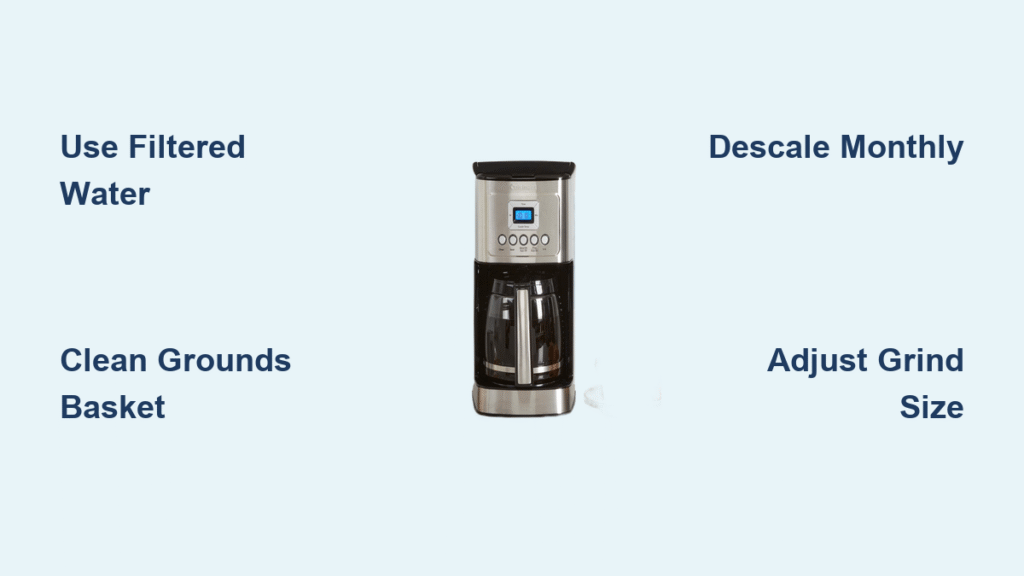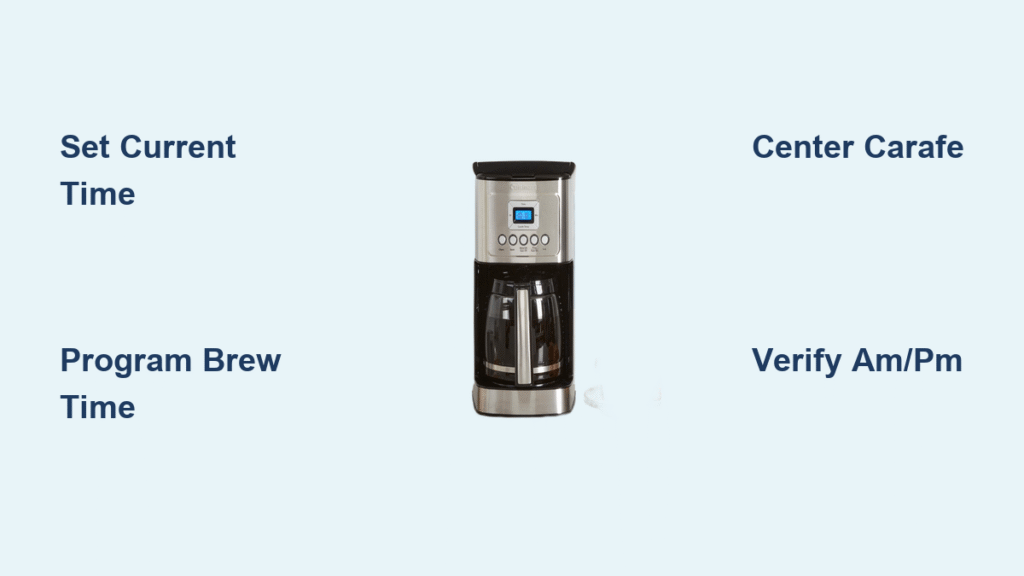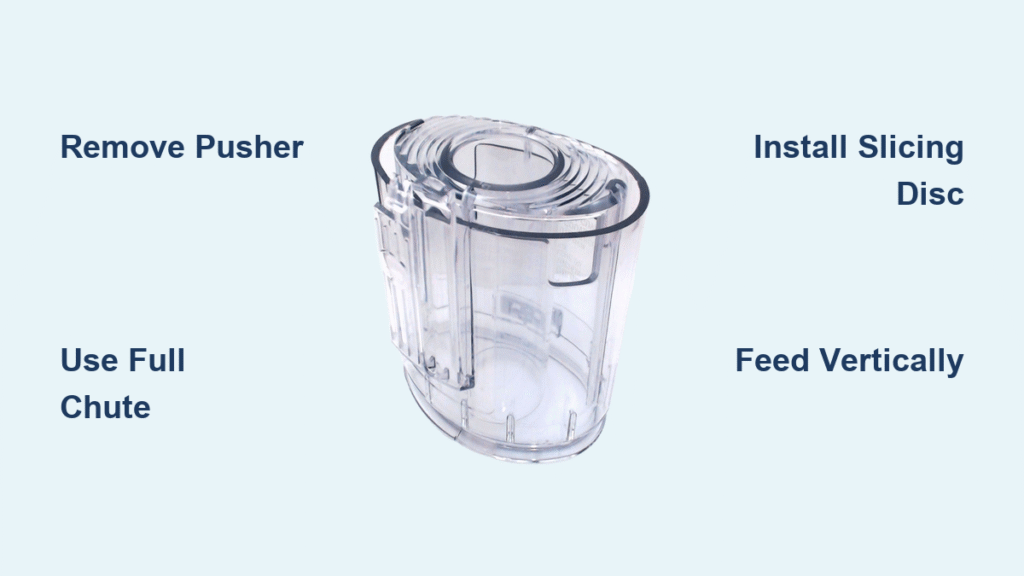Your Cuisinart coffeemaker should deliver rich, aromatic coffee that jumpstarts your morning—not watery disappointment or bitter sludge. Yet too many users end up with inconsistent brews simply because they’ve never unlocked their machine’s full potential. Whether you own a Coffee on Demand dispenser, Perfec Temp model, or Grind & Brew system, this guide cuts through the confusion with model-specific techniques backed by Cuisinart’s engineering. You’ll discover why your coffee tastes off, master the exact water-to-coffee ratios that transform mediocre brews, and fix common issues in under 60 seconds. Most importantly, you’ll learn the single mistake 80% of users make with the 1-4 cup button that ruins extraction.
Select Your Cuisinart Model’s Brewing Protocol
Coffee on Demand Single-Serve Activation
These models brew 4-12 cups at once but dispense coffee incrementally. Critical step: Always check the “fuel gauge” before brewing—running the reservoir dry overheats the heating element within 30 seconds. Never remove the pot for more than 15 seconds during brewing; unlike Sneak-a-Cup models, these lack automatic flow resumption. If coffee stops mid-dispense, unplug for 30 seconds to reset the pump.
Perfec Temp Hotter-Brewing Adjustment
These units heat water 25-30°F hotter than standard models for milk drinkers who hate lukewarm lattes. Key limitation: The 1-4 cup setting is disabled—these require full pots (5+ cups) to maintain thermal stability. Brew weak coffee? Reduce beans by 20% since hotter water extracts more compounds. Warning: Never use glass carafes with these models; thermal shock cracks them instantly.
Grind & Brew Whole-Bean Safety Rules
Non-negotiable rule: Add only whole beans to the hopper—ground coffee clogs the grinder mechanism. If using pre-ground, disable the grind function via the “Grind Off” button (not all models have this; consult your manual). Weekly fix: Lift the bean basket and brush out static-charged grounds trapped beneath it—this buildup causes bitter, over-extracted coffee within days.
Execute Precision Pre-Brew Setup

Water Reservoir Calibration
Fill to the exact cup line on the reservoir’s clear gauge—overfilling causes overflow, underfilling creates weak coffee. Pro technique: Use chilled filtered water (not tap) poured slowly down the side to avoid splashing. For 1-4 cup batches, press the dedicated button before adding coffee—activating it mid-process confuses the sensor, triggering beeping errors.
Filter and Coffee Measurement System
Choose paper filters for brighter acidity or gold-tone filters for fuller body, but never exceed 12 tablespoons in 10-cup models (2 tablespoons over capacity). For Grind & Brew units:
1. Add beans to the hopper (max 10 oz)
2. Set grind size to “medium” for drip coffee
3. Measure after grinding—volume increases 30% when ground
Critical error: Using oversized scoops adds 25% extra coffee, causing overflow and bitter sludge. Stick to Cuisinart’s included scoop (1 tbsp).
Activate Flawless Brewing Cycles
Standard Model Start Sequence
- Plug into a dedicated outlet (shared circuits cause voltage drops)
- Rotate control knob to “Brew” position—never “Warm”
- Press start button until it clicks (soft presses register as errors)
- Listen for the single completion beep—multiple beeps mean failure
Urgent fix: If brewing stops early, check if the carafe is fully seated; 90% of “stuck” brews stem from misalignment.
Sneak-a-Cup Mid-Brew Access
Available on Grind & Brew and Thermal Carafe models:
– Remove carafe for up to 45 seconds without spillage
– Flow resumes automatically when replaced—no button needed
– If coffee drips: Wipe the carafe lip with a dry cloth; moisture disrupts the seal
Never do this: On non-Sneak-a-Cup models—removing the pot triggers immediate overflow.
Program Mode Cold-Start Setup
For 6 AM coffee:
1. Set current time (AM/PM confusion causes 6 PM brews)
2. Press “Prog” until display flashes
3. Set brew time using hour/minute buttons
4. Press “Prog” again to confirm
Time-saving hack: Program after adding coffee/water—dry components degrade if left overnight.
Resolve Beeping and Flavor Failures Immediately

Tri-Point Beep Diagnosis
When your Cuisinart beeps repeatedly at startup:
1. Empty grounds basket—residual grounds cause electrical shorts
2. Re-seat carafe lid—misaligned lids trigger safety locks
3. Check bean hopper (Grind & Brew only)—empty hoppers overheat grinders
If unresolved: Unplug for 2 minutes to reset the motherboard.
Weak Coffee Emergency Fixes
Within 30 seconds of brewing:
– Too watery? Add 1 tbsp extra coffee to the basket and restart
– Lacks body? Switch to medium-fine grind (table salt texture)
– Flat taste? Replace beans—stale coffee loses 70% of aroma compounds after 2 weeks
Never add water mid-brew—it disrupts extraction chemistry.
Bitter Coffee Cure Protocol
Stop brewing immediately if:
– Grind is too fine (like powdered sugar)—causes over-extraction
– Coffee sits >4 hours in carafe—chemical degradation begins at 175°F
– Scale buildup exists—vinegar smell during brewing confirms it
Solution: Run a descaling cycle before next use (see maintenance section).
Optimize the Four Coffee Excellence Factors
Water Quality Temperature Control
Use cold filtered water—hot tap water contains dissolved metals that create metallic aftertastes. Critical insight: Cuisinart’s heating elements reach optimal extraction temp (195-205°F) only with cold water input. Hard water users: Install a $15 charcoal filter to prevent scale-induced bitterness.
Bean Freshness Preservation System
Buy 7-day supplies max and store in opaque airtight containers (not the freezer—condensation destroys volatile compounds). Grind timing rule: Whole beans stay fresh 14x longer than pre-ground. If using pre-ground, brew within 30 minutes of opening the bag.
Grind Size Extraction Chart
| Brew Method | Ideal Texture | Error Symptoms |
|---|---|---|
| Drip Coffee | Medium-fine (sand) | Coarse = weak, Fine = bitter |
| French Press | Coarse (sea salt) | Over-extraction in 4 minutes |
| Espresso | Extra-fine (powder) | Clogs Cuisinart filters |
Ratio Adjustment Decision Tree
Start with 1 tbsp per cup, then:
– Weak coffee? → Add 0.5 tbsp per cup (max 1.5)
– Bitter coffee? → Reduce to 0.75 tbsp per cup
– Dark roasts? → Use 20% less coffee (roast intensity amplifies flavor)
Never measure by volume—use a 10g coffee scale for precision.
Implement the 3-Tier Cleaning System
Post-Brew Emergency Protocol
- Within 5 minutes: Empty grounds basket (stale grounds turn rancid)
- Rinse carafe/basket with non-abrasive soap—never let coffee oils dry
- Air-dry components upside down—towels leave lint that clogs filters
- Wipe base with vinegar-dampened cloth to neutralize coffee acids
Weekly Grind & Brew Deep Clean
Lift the bean basket and:
1. Brush grounds from the grinder chamber with a dry toothbrush
2. Vacuum crevices with a handheld attachment
3. Wipe hopper with a microfiber cloth (no liquids near electronics)
Skip this step: Expect bitter, inconsistent coffee within 10 brews.
Monthly Descaling Lifesaver
Solution: 1/3 white vinegar + 2/3 water (never use citric acid—it damages seals).
1. Fill reservoir to MAX line
2. Run full cycle without coffee
3. Discard solution, run two plain water cycles
4. Critical test: Smell the carafe—vinegar odor means repeat rinsing
Frequency: Heavy users (3+ pots/day) descale weekly; others monthly.
Master these Cuisinart-specific techniques, and you’ll never waste $20 worth of beans on undrinkable coffee again. Start with the 1:1 tablespoon-to-cup ratio, then adjust based on your model’s quirks—Perfec Temp units need 15% less coffee, while Coffee on Demand models require precise water levels. Most importantly, clean your machine within 5 minutes of brewing; coffee oils polymerize into bitter residue that ruins subsequent pots. Commit to monthly descaling, and your Cuisinart will deliver café-quality brews for 5+ years. For thermal carafe models, remember: never pour hot coffee into a cold carafe—pre-warm it with hot tap water first to prevent thermal shock. Your perfect cup starts today.





